
Locks on the River Thames
Encyclopedia
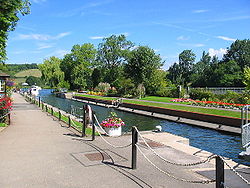
England
England is a country that is part of the United Kingdom. It shares land borders with Scotland to the north and Wales to the west; the Irish Sea is to the north west, the Celtic Sea to the south west, with the North Sea to the east and the English Channel to the south separating it from continental...
River Thames
River Thames
The River Thames flows through southern England. It is the longest river entirely in England and the second longest in the United Kingdom. While it is best known because its lower reaches flow through central London, the river flows alongside several other towns and cities, including Oxford,...
is navigable from Cricklade
Cricklade
Cricklade is a town and civil parish on the River Thames in north Wiltshire in England, midway between Swindon and Cirencester.On 25 September 2011 Cricklade was awarded The Royal Horticultural Society's 'Champion of Champions' award in the Britain in Bloom competition.Cricklade is twinned with...
(for small boats) or Lechlade
Lechlade
Lechlade, or Lechlade-on-Thames, is a town at the southern edge of the Cotswolds in Gloucestershire, England. It is the highest point at which the River Thames is navigable. The town is named after the River Leach that joins the Thames near here....
(for larger boats) to the sea, and this part of the river falls 71 metres (234 feet). There are 45 locks
Lock (water transport)
A lock is a device for raising and lowering boats between stretches of water of different levels on river and canal waterways. The distinguishing feature of a lock is a fixed chamber in which the water level can be varied; whereas in a caisson lock, a boat lift, or on a canal inclined plane, it is...
on the river, each with one or more adjacent weir
Weir
A weir is a small overflow dam used to alter the flow characteristics of a river or stream. In most cases weirs take the form of a barrier across the river that causes water to pool behind the structure , but allows water to flow over the top...
s. These lock and weir combinations are used for controlling the flow of water down the river, most notably when there is a risk of flooding, and provide for navigation above the tideway
Tideway
The Tideway is a name given to the part of the River Thames in England that is subject to tides. This stretch of water is downstream from Teddington Lock and is just under long...
.
History
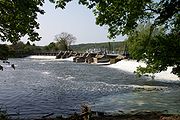
Watermill
A watermill is a structure that uses a water wheel or turbine to drive a mechanical process such as flour, lumber or textile production, or metal shaping .- History :...
s for the production of flour and paper and various other purposes such as metal-beating. This involved the construction of weirs in order to divert water into the mills. The weirs, however, presented an obstacle to navigation and to solve this problem locks were built alongside the weirs to enable boats to be moved between levels.
Originally these were flash lock
Flash lock
Early locks were designed with a single gate, known as a flash lock or staunch lock. The earliest European references to what were clearly flash locks were in Roman times....
s that were essentially removable sections of weir. A boat moving downstream would wait above the lock until the lock was opened, which would allow a "flash" of water to pass through, carrying the boat with it. In the opposite direction boats would be winched or towed through the open lock. The difficulty of using flash locks, and the consequent loss of water and income to the miller, eventually led to their replacement with pound locks
Lock (water transport)
A lock is a device for raising and lowering boats between stretches of water of different levels on river and canal waterways. The distinguishing feature of a lock is a fixed chamber in which the water level can be varied; whereas in a caisson lock, a boat lift, or on a canal inclined plane, it is...
. Locks similar to these early pound locks still exist on the river, although in many cases they have been enlarged and mechanised.
On the lower section, the river was tidal
Tide
Tides are the rise and fall of sea levels caused by the combined effects of the gravitational forces exerted by the moon and the sun and the rotation of the Earth....
as far as Staines
Staines
Staines is a Thames-side town in the Spelthorne borough of Surrey and Greater London Urban Area, as well as the London Commuter Belt of South East England. It is a suburban development within the western bounds of the M25 motorway and located 17 miles west south-west of Charing Cross in...
until the beginning of the 19th century and was under the control of the City of London
City of London
The City of London is a small area within Greater London, England. It is the historic core of London around which the modern conurbation grew and has held city status since time immemorial. The City’s boundaries have remained almost unchanged since the Middle Ages, and it is now only a tiny part of...
. The City's jurisdiction was marked by the London Stone
London Stone (riparian)
London Stone is the name given to a number of boundary stones which stand beside rivers in south east England.-History:Until 1350, the English Crown held the right to fish the rivers of England and charged duties on those people it licenced to fish...
. The principle of lock/weir combination, which maintained the depth of water for navigation and reduced the danger of flooding, was extended over the tidal section as far as Teddington
Teddington
Teddington is a suburban area in the London Borough of Richmond upon Thames in south west London, on the north bank of the River Thames, between Hampton Wick and Twickenham. It stretches inland from the River Thames to Bushy Park...
in a series of locks built after 1810.
The first authority charged with managing navigation and lock building was the Oxford-Burcot Commission
Oxford-Burcot Commission
The Oxford-Burcot Commission was the first Commission concerned with the management of the River Thames, appointed by an Act of Parliament of 1605 by James I to make the stretch of river from Burcot to Oxford navigable. The Commission took responsibility for the management of the River Thames...
, which built the locks at Iffley and Sandford below Oxford in 1633 and at Swift Ditch near Abingdon. In 1751, the Thames Navigation Commissioners were established and built eight locks between Shiplake Lock and Boulters lock between 1770 and 1773. The opening of the Thames and Severn Canal
Thames and Severn Canal
The Thames and Severn Canal is a canal in Gloucestershire in the south of England, which was completed in 1789. It was conceived as part of a canal route from Bristol to London. At its eastern end, it connects to the River Thames at Inglesham Lock near Lechlade, while at its western end, it...
from Lechlade in 1789 led to the building of many of the locks upstream of Shiplake. The locks built on the tidal section required individual Acts of Parliament, and the Thames Conservancy
Thames Conservancy
The Thames Conservancy was a historical body responsible for the management of the River Thames in England. It was founded in 1857, initially replacing the jurisdiction of the City of London up to Staines and later taking responsibility for the whole river from Cricklade in Wiltshire to the sea at...
took over their management from the City in 1857. In 1866 the Thames Conservancy became responsible for all river management and installed more locks over the years, the last being Eynsham and King’s in 1928. In 1908 an Act transferred responsibility for the Thames from a point 350 yards (320 m) below Teddington Lock to the Port of London Authority
Port of London Authority
The Port of London Authority is a self-funding public trust established in 1908 by the Port of London Act to govern the Port of London. Its responsibility extends over the Tideway of the River Thames and the authority is responsible for the public right of navigation and for conservancy of the...
, and this included Richmond Lock. The Thames Conservancy was subsumed into the Thames Water Authority
Thames Water Authority
The Thames Water Authority was one of ten Regional Water Authorities created in the UK in 1975 to bring together all the water management functions of the Region in one public body....
in 1974. With the privatization of water supply in 1990 the river management functions passed to the new National Rivers Authority
National Rivers Authority
The National Rivers Authority was one of the forerunners of the Environment Agency of England and Wales, existing between 1989 and 1996. Before 1989 the regulation of the aquatic environment had largely been carried out by the ten Regional Water Authorities...
and in 1996 to the Environment Agency. Only Richmond Lock remains under the jurisdiction of the Port of London Authority.
Operation

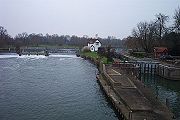
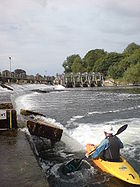
Management
From the head of navigation at Cricklade to the start of the tidalTide
Tides are the rise and fall of sea levels caused by the combined effects of the gravitational forces exerted by the moon and the sun and the rotation of the Earth....
section at Teddington Lock
Teddington Lock
Teddington Lock is a complex of three locks and a weir on the River Thames in England at Ham in the western suburbs of London. The lock is on the southern Surrey side of the river....
, the river is managed by the Environment Agency
Environment Agency
The Environment Agency is a British non-departmental public body of the Department for Environment, Food and Rural Affairs and an Assembly Government Sponsored Body of the Welsh Assembly Government that serves England and Wales.-Purpose:...
, which has the twin responsibilities of managing the flow of water to control flooding and provide navigable water depths and also regulating and promoting navigation on the river. As a result all the locks and weirs on the river, except the semi-tidal Richmond Lock, are owned and operated by the Environment Agency. Richmond Lock is managed by the Port of London Authority
Port of London Authority
The Port of London Authority is a self-funding public trust established in 1908 by the Port of London Act to govern the Port of London. Its responsibility extends over the Tideway of the River Thames and the authority is responsible for the public right of navigation and for conservancy of the...
.
Each of the Environment Agency's locks and weirs is manned by a lock keeper
Lock keeper
A Lock keeper, or lock operator looks after a canal or river lock, operating it and if necessary maintaining it or organizing its maintenance. Traditionally, the lock keeper lived on-site, often in a small purpose-built cottage. The occupation is dying out...
, who normally lives in a house adjacent to the lock. The lock keeper's duties involve both operating the lock, and managing the river levels above the lock by adjusting the weir openings.
Locks
Most locks are operated by their keepers between 9 a.m. and 7 p.m. from June to August, with progressively shorter hours as the hours of daylight reduce, and they are not operated during the lock-keeper's lunch hour between 1 p.m. and 2 p.m. During the summer months Assistant Lock Keepers are employed to deal with the heavy traffic and avoid the lunch-time closure. However Teddington LockTeddington Lock
Teddington Lock is a complex of three locks and a weir on the River Thames in England at Ham in the western suburbs of London. The lock is on the southern Surrey side of the river....
, which is the most downstream of the Environment Agency locks and separates the non-tidal river from the tideway, is manned 24 hours a day. During winter, some locks will be closed for maintenance and the status has to be checked with the Environment Agency.
The locks at the upper end of the river, from St John's Lock
St John's Lock
St John's Lock is a lock on the upper reaches of the River Thames in England, near the town of Lechlade, Gloucestershire. It is the highest lock on the river. It is named after a priory that was established nearby in 1250, which no longer exists. The lock was built of stone in 1790 by the Thames...
to King's Lock
King's Lock
King's Lock is a lock on the River Thames in England. It is in open country to the north of Oxford, Oxfordshire, on the southern bank of the river. The lock was one of the last pound locks built on the Thames being built by the Thames Conservancy in 1928 to replace the former flash lock.At the lock...
, are manually operated. All other locks on the Thames are hydraulically operated. All locks, except Teddington, can be operated by boat crews outside manning hours, using the adapted system of "public power", which allows boaters to use the hydraulic machinery at reduced power, except during the hours of darkness.
Locks are popular visitor attractions, and many serve refreshments. Locks were often built adjacent to islands and therefore many are situated in remote locations, hard to find and can only be reached on foot.
Weirs
The Environment Agency has the responsibility of managing the flow of water along the length of the river to prevent flooding on particular reaches and to maintain navigation depths. The volume and speed of water down the river is managed by adjusting the gates at each weir. Occasionally this can result in a fast stream rendering navigation more hazardous. These conditions are indicated by yellow or red warning boards on the lock gates and the status of all locks is published by the Agency. The Agency cannot legally stop navigation when the red boards are out, but continuing to travel is inadvisable and may invalidate a boater's insurance.Occasionally flooding is unavoidable, and the Agency issues Flood Warnings with four levels of severity - Flood Watch, Flood Warning, Severe Flood Warning and All Clear.
In recent years the Salmon Conservancy
North Atlantic Salmon Conservation Organization
The North Atlantic Salmon Conservation Organization is an international organization established under the Convention for the Conservation of Salmon in the North Atlantic Ocean from October 1 1983....
has been installing fish ladder
Fish ladder
A fish ladder, also known as a fishway, fish pass or fish steps, is a structure on or around artificial barriers to facilitate diadromous fishes' natural migration. Most fishways enable fish to pass around the barriers by swimming and leaping up a series of relatively low steps into the waters on...
s at weirs to allow salmon
Salmon
Salmon is the common name for several species of fish in the family Salmonidae. Several other fish in the same family are called trout; the difference is often said to be that salmon migrate and trout are resident, but this distinction does not strictly hold true...
to travel up river.
Today some weirs are often used recreationally by kayakers and canoeists for activities such as whitewater slalom and playboating
Playboating
Playboating is a discipline of whitewater kayaking or canoeing where the paddler performs various technical moves in one place , as opposed to downriver whitewater canoeing or kayaking where the objective is to travel the length of a section of river...
. Specifically, Hambleden Weir
Hambleden Lock
Hambleden Lock is a lock with a long weir situated on the River Thames in England. The lock is on the Berkshire bank between Aston and Remenham...
and Boulter's Weir
Boulter's Lock
Boulter's Lock is a lock and weir on the River Thames in England on the eastern side of Maidenhead, Berkshire. A lock was first built here by the Thames Navigation Commission in 1772. The lock is on the western side of the river between the main Maidenhead to Cookham road and Ray Mill Island...
have EA
Environment Agency
The Environment Agency is a British non-departmental public body of the Department for Environment, Food and Rural Affairs and an Assembly Government Sponsored Body of the Welsh Assembly Government that serves England and Wales.-Purpose:...
sanctioned modifications made to them for such use.
Reaches
The locks and weirs, in effect, break the river up into 44 lakes or lock reaches. Each lock controls the reach above it and thus identifies it. Each reach has its own character and points of interest.Many reaches host regatta
Regatta
A regatta is a series of boat races. The term typically describes racing events of rowed or sailed water craft, although some powerboat race series are also called regattas...
s and other events and these are coordinated through a River User’s Group for the reach. The Environment Agency may close all or part of a reach for an event, but most regattas only require one side of the river which may then be closed off.
When the boats were horse drawn
Horse-drawn boat
A horse-drawn boat or tow-boat is a historic boat operating on a canal, pulled by a horse walking on a special road along the canal, the towpath.-United Kingdom:...
, a towpath
Towpath
A towpath is a road or trail on the bank of a river, canal, or other inland waterway. The purpose of a towpath is to allow a land vehicle, beasts of burden, or a team of human pullers to tow a boat, often a barge...
was needed on the bank side. This towpath has formed the basis for the Thames Path
Thames Path
The Thames Path is a National Trail, opened in 1996, following the length of the River Thames from its source near Kemble in Gloucestershire to the Thames Barrier at Charlton. It is about long....
which runs between the source and mouth of the river. The path runs between locks and is therefore often the main means of access on land. Where the towpath changes from one side of the river to the other ferries were once provided. These have now almost all disappeared and the Thames Path has to be diverted to the nearest bridge, often a considerable distance, to cope with this.
List of locks and weirs

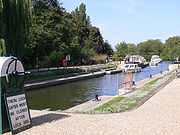
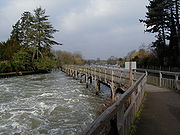
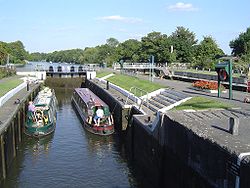
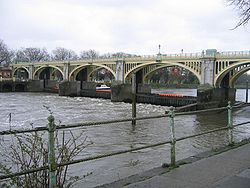
- St John's LockSt John's LockSt John's Lock is a lock on the upper reaches of the River Thames in England, near the town of Lechlade, Gloucestershire. It is the highest lock on the river. It is named after a priory that was established nearby in 1250, which no longer exists. The lock was built of stone in 1790 by the Thames...
(1790) - Buscot LockBuscot LockBuscot Lock is a lock on the River Thames in England, near the village of Buscot, Oxfordshire.The lock was built of stone by the Thames Navigation Commission in 1790 and is the smallest on the River Thames...
(1790) - Grafton LockGrafton LockGrafton Lock is a lock on the River Thames in England on the northern bank between Kelmscott and Radcot Oxfordshire. The lock was built by the Thames Conservancy in 1896.The weir is on the other side of the lock island at the upstream end....
(1896) - Radcot LockRadcot LockRadcot Lock is a lock on the River Thames in England just downstream of Radcot, Oxfordshire, on the southern bank.The lock was built by the Thames Conservancy in 1892 on the site of an old weir and flash lock....
(1892) - Rushey LockRushey LockRushey Lock is a lock on the River Thames in England. It is on the northern bank of the river in Oxfordshire, a considerable distance from any village, the nearest being Buckland Marsh, a hamlet on the road to Buckland to the south of the river....
(1790) - Shifford LockShifford LockShifford Lock is a lock on the River Thames in England. It is in the centre of a triangle formed by the small villages of Shifford, Duxford and Chimney in Oxfordshire. It is at the start of a navigation cut built with the lock by the Thames Conservancy in 1898...
(1898) - Northmoor LockNorthmoor LockNorthmoor Lock is a lock on the River Thames in Oxfordshire, England, on the northern bank about a mile from Northmoor.The lock was built in 1896 by the Thames Conservancy to replace a flash lock at Hart's Weir, also known as Ridge's Weir, about a mile upstream and another at Ark Weir downstream...
(1896) - Pinkhill LockPinkhill LockPinkhill Lock is a lock on the River Thames in England. It is close to Farmoor, Oxfordshire.The first lock was built of stone by Daniel Harris for the Thames Navigation Commission in 1791....
(1791) - Eynsham LockEynsham LockEynsham Lock is a lock on the River Thames in England. It is on the southern bank near Swinford Oxfordshire. The large village of Eynsham is a little distance away on the northern bank....
(1928) - King's LockKing's LockKing's Lock is a lock on the River Thames in England. It is in open country to the north of Oxford, Oxfordshire, on the southern bank of the river. The lock was one of the last pound locks built on the Thames being built by the Thames Conservancy in 1928 to replace the former flash lock.At the lock...
(1928) - Godstow LockGodstow LockGodstow Lock is a lock on the River Thames in Oxfordshire, England. It is between the villages of Wolvercote and Wytham on the outskirts of Oxford. The first lock was built of stone by Daniel Harris for the Thames Navigation Commission in 1790...
(1790) - Osney LockOsney LockOsney Lock is a lock on the River Thames in Oxfordshire, England. It is close to Oxford where the village or island of Osney is next to the river.The first lock was built of stone by Daniel Harris for the Thames Navigation Commission in 1790....
(1790) - Iffley LockIffley LockIffley Lock is a lock on the River Thames in England near the village of Iffley, Oxfordshire. It is on the southern outskirts of Oxford. The original lock was built by the Oxford-Burcot Commission in 1631 and the Thames Navigation Commission replaced this in 1793...
(1631) - Sandford LockSandford LockSandford Lock is a lock on the River Thames in England, situated at Sandford-on-Thames which is just South of Oxford. The first pound lock was built in 1631 by the Oxford-Burcot Commission although this has since been rebuilt...
(1631) - Abingdon LockAbingdon LockAbingdon Lock is a lock on the River Thames in England, less than 1 mile east and upstream of Abingdon, Oxfordshire on the opposite bank of the river...
(1790) - Culham LockCulham LockCulham Lock is a lock on the River Thames in England close to Culham, Oxfordshire. It is on a lock cut to the north of the main stream, which approaches the large village of Sutton Courtenay...
(1809) - Clifton LockClifton LockClifton Lock is a lock on River Thames in Oxfordshire, England. It is located south of the village of Clifton Hampden and north of Long Wittenham...
(1822) - Day's LockDay's LockDay's Lock is a lock on the River Thames near Dorchester-on-Thames, Oxfordshire, England on the Dorchester side of the river.The pound lock was built in 1789 by the Thames Navigation Commissioner...
(1789) - Benson LockBenson LockBenson Lock is a lock on the River Thames in England, close to Benson, Oxfordshire but on the opposite bank of the river. The first pound lock here was built by the Thames Navigation Commission in 1788 and it was replaced by the present masonry lock in 1870...
(1788) - Cleeve LockCleeve LockCleeve Lock is a lock on the River Thames, in Oxfordshire, England. It is located just upstream of Streatley on the same side of the river. The village of Cleeve is on the opposite bank near Goring ....
(1787) - Goring LockGoring LockGoring Lock is a lock and weir situated on the River Thames in England at the Goring Gap in the Chiltern Hills. The lock is located on the Oxfordshire bank at Goring-On-Thames, with Streatley, Berkshire on the opposite side of the river. It is just upstream of Goring and Streatley Bridge...
(1787) - Whitchurch LockWhitchurch LockWhitchurch Lock is a lock and weir situated on the River Thames in England. It is a pound lock, built by the Thames Navigation Commissioners in 1787...
(1787) - Mapledurham LockMapledurham LockMapledurham Lock is a lock and weir situated on the River Thames in England. The lock was first built in 1777 by the Thames Navigation Commissioners and the present lock dates from 1908....
(1778) - Caversham LockCaversham LockCaversham Lock is a lock and weir situated on the River Thames in England at Reading, Berkshire. The lock is connected to De Bohun Island, a somewhat larger than normal lock island...
(1778) - Sonning LockSonning LockSonning Lock is a lock and associated weir situated on the River Thames at the village of Sonning near Reading, Berkshire, England. The first lock was built by the Thames Navigation Commission in 1773 and it has been rebuilt three times since then....
(1773) - Shiplake LockShiplake LockShiplake Lock is a lock and weir situated on the River Thames in England near the village of Shiplake, Oxfordshire. It is just above the points where the River Loddon joins the Thames and Shiplake Railway Bridge crosses the river...
(1773) - Marsh LockMarsh LockMarsh Lock is a lock and weir situated on the River Thames in England near Henley-on-Thames, Oxfordshire. The lock is close to the Berkshire bank, but accessed from the Oxfordshire side via two long walkways, the downstream one being near Mill Meadows...
(1773) - Hambleden LockHambleden LockHambleden Lock is a lock with a long weir situated on the River Thames in England. The lock is on the Berkshire bank between Aston and Remenham...
(1773) - Hurley LockHurley LockHurley Lock is a lock and weir on the River Thames in England, situated in a clump of wooded islands close to the village of Hurley, Berkshire. The lock was first built by the Thames Navigation Commissioners in 1773....
(1773) - Temple LockTemple LockTemple Lock is a lock and weir situated on the Buckinghamshire bank of the River Thames near Temple Mill Island opposite Temple Meadows and not far from Hurley, Berkshire...
(1773) - Marlow LockMarlow LockMarlow Lock is a lock and weir situated on the River Thames in the town of Marlow, Buckinghamshire, England. The first pound lock was built by the Thames Navigation Commission in 1773.The weir stretches a long way upstream above the lock.-History:...
(1773) - Cookham LockCookham LockCookham Lock is a lock with weirs situated on the River Thames near Cookham, Berkshire. The lock is set in a lock cut which is one of four streams here and it is surrounded by woods. On one side is Sashes Island and on the other is Mill Island connected to Formosa Island, the largest on the...
(1830) - Boulter's LockBoulter's LockBoulter's Lock is a lock and weir on the River Thames in England on the eastern side of Maidenhead, Berkshire. A lock was first built here by the Thames Navigation Commission in 1772. The lock is on the western side of the river between the main Maidenhead to Cookham road and Ray Mill Island...
(1772) - Bray LockBray LockBray Lock is a lock and weir on the River Thames in England near Bray and Dorney and is just above the M4 Bridge across the Thames. The lock is on the Buckinghamshire side of the river on the opposite bank from Bray itself and Maidenhead which are in Berkshire...
(1845) - Boveney LockBoveney LockBoveney Lock is a lock on the River Thames situated on the Buckinghamshire bank opposite the Windsor Racecourse and close to Eton Wick. Boveney is a village a little way upstream on the same side. The lock was first built in 1838 by the Thames Navigation Commission...
(1838) - Romney LockRomney LockRomney Lock is a lock on the River Thames in England near Windsor and Eton. It is on the Windsor side of the river next to a boatyard and adjoins Romney Island, a long strip of land in the middle of the river. The first lock was built by the Thames Navigation Commission in 1798.The weir is some...
(1798) - Old Windsor LockOld Windsor LockOld Windsor Lock is a lock on the River Thames in England close to Old Windsor on the side of the river towards the town. The lock marks the start of the New Cut, built in 1822 by the Thames Navigation Commissioners, which created Ham Island in the hook of the old river...
(1822) - Bell Weir LockBell Weir LockBell Weir Lock is a lock on the River Thames in England situated on the Surrey bank near Egham. It is just upstream of the M25 Runnymede Bridge which carries the M25 and A30 road across the river...
(1817) - Penton Hook LockPenton Hook LockPenton Hook Lock is a lock on the River Thames in England situated on the northern "Middlesex" bank near Laleham, Surrey.The lock cuts across a large loop or hook in the river, creating Penton Hook Island There is a large marina in the disused gravel pits connected to this loop...
(1815) - Chertsey LockChertsey LockChertsey Lock is a lock on the River Thames in England, on the northern Middlesex bank near Chertsey in north-west Surrey. The lock is about 200 yards upstream of the picturesque Chertsey Bridge...
(1813) - Shepperton LockShepperton LockShepperton Lock is a lock on the River Thames, in England adjoining the northern bank near Shepperton, Surrey . It is across the river from Weybridge, but not directly accessible from there....
(1813) - Sunbury LockSunbury LockSunbury Lock is a lock on the River Thames in England near Walton-on-Thames in north-west Surrey. The lock adjoins the southern bank about half a mile downstream of the Weir Hotel....
(1812) - Molesey LockMolesey LockMolesey Lock is a lock on the River Thames in England at East Molesey, Surrey. It is near Hampton Court Palace to the west of London.The lock was built by the City of London Corporation in 1815 and is the second longest on the river at over 268 ft . Beside the lock there are rollers for the...
(1815) - Teddington LockTeddington LockTeddington Lock is a complex of three locks and a weir on the River Thames in England at Ham in the western suburbs of London. The lock is on the southern Surrey side of the river....
(1811) - Richmond Lock (1894)
Additionally, Blake's Lock
Blake's Lock
Blake's Lock is a lock situated on the River Kennet in Reading, Berkshire, England. It is on the short reach of the River Kennet which is administered as if it were part of the River Thames and is hence owned and managed by the Environment Agency....
is located on a reach of the River Kennet
River Kennet
The Kennet is a river in the south of England, and a tributary of the River Thames. The lower reaches of the river are navigable to river craft and are known as the Kennet Navigation, which, together with the Avon Navigation, the Kennet and Avon Canal and the Thames, links the cities of Bristol...
that is administered by the Environment Agency as part of the River Thames, and is often counted as a Thames Lock. It is the only manual Thames lock below Oxford.
Chalmore Lock
Chalmore Lock
Chalmore Lock was a lock and weir which operated between 1838 and 1883 on the River Thames in England near Wallingford, Oxfordshire.-History:Chalmore Lock was built in 1838 by the Thames Navigation Commissioners at a place called Chalmore Hole between Cleeve Lock and Benson Lock. It was built as a...
(1838) was removed in 1883.
See also
- Thames BarrierThames BarrierThe Thames Barrier is the world's second-largest movable flood barrier and is located downstream of central London. Its purpose is to prevent London from being flooded by exceptionally high tides and storm surges moving up from the sea...
- Crossings of the River ThamesCrossings of the River ThamesThis is a list of crossings of the River Thames including bridges, tunnels and ferries. There are 214 bridges, over 20 tunnels, six public ferries and one ford.-Barrier and boundary:...
- Islands in the River ThamesIslands in the River ThamesThis article lists the islands in the River Thames, in England. It excludes many of the smaller lock islands that were created when weirs and locks were built, and also some very small islands that immediately adjoin the larger ones. The Isle of Dogs and Isle of Grain are no longer islands although...
External links
- The must have guide for all Thames users (published by the Environment Agency)
- Environment Agency
- Floating down the river

